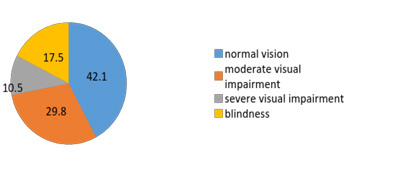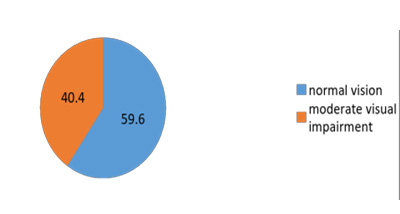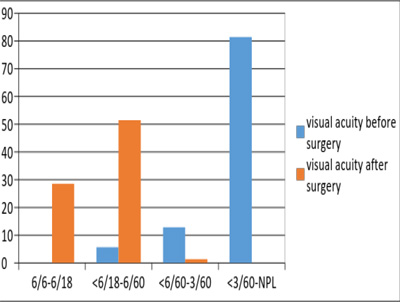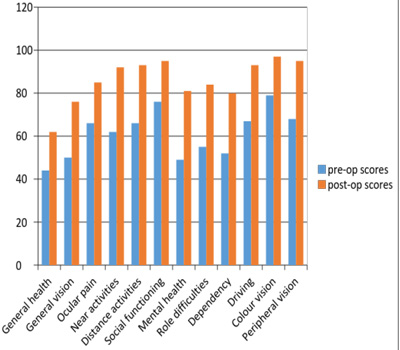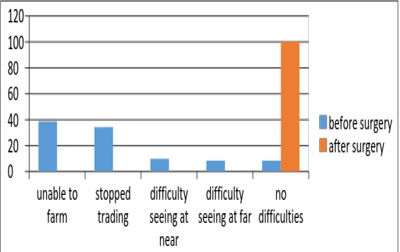Previous Issues Volume 1, Issue 1 - 2016
Quality of Life of Cataract Patients Before and After Surgery-Evidence From Four Rural Communities in Ghana
Angela Ofeibea Amedo1,Nana Yaa Koomson1,Tchiakpe Michel Pascal1,David Ben Kumah1,Jennifer Nana Afia Ocansey1,Bright Asare-Bediako1
1Department of Optometry and Visual Science, Kwame Nkrumah University of Science and Technology, Kumasi, Ghana.
2Department of Optometry, Madonna University, Elele, Rivers State, Nigeria.
Corresponding Author: Angela Ofeibea Amedo, Department of Optometry and Visual Science, B8 COS Building, KNUST-Kumasi, Ghana. Tel: +233242515080; E-Mail: [email protected]
Received Date: 27 Apr 2016 Accepted Date: 07 Jun 2016 Published Date: 13 Jun 2016
Copyright © 2016 Amedo AO
Citation: Amedo AO, Koomson NY, Pascal TM, Kumah DB, et al. (2016). Quality of Life of Cataract Patients Before and After Surgery-Evidence From Four Rural Communities in Ghana. Mathews J Ophthalmol. 1(1): 003.
ABSTRACT
Background:Cataract is one of the main causes of blindness worldwide and the quality of life of such patients is reported to be low. Cataract surgery has been reported to improve the quality of life of patients in developed countries. The purpose of this study was to investigate the quality of life of cataract patients before and after surgery in four rural communities in Ghana.
Methods:Seventy patients who had been scheduled for cataract surgery at hospitals in the rural communities were studied using a slightly modified National EyeInstitute’s Visual Functioning Questionnaire (NEI VFQ-25) before the surgery and two months after surgery. Visual acuity was assessed using a Snellen Chart at 6 metres. Data was analyzed using SPSS version 20.
Results:70 participants aged 12 to 99 years comprising 52.3% females were interviewed before surgery and 13(18.57%) were lost to follow up after surgery. There was significant improvement in all subscale scores (p < 0.001) and an 18.48 points increase in the composite score. Improvement in visual acuity and reduction in visual impairment after surgery were significant. Patients who could not perform certain daily living activities resumed such activities two months after cataract surgery.
Conclusion:Cataract surgery improved the quality of life in patients living in the rural communities and underscores the need to increase the rate of cataract surgery in developing countries and low income settings.
INTRODUCTION
Cataracts are symptomatic lens opacities that obstruct the passage of light onto the retina due to loss of transparency and cause a reduction in vision. Globally, cataract is reported to be the main cause of blindness, responsible for about seventeen (17) million (39%) of the 45 million cases of blindness, and the vast majority of cases live in low income countries [1, 2]. In Ghana, it is estimated that 600,000 people are visually impaired and 200,000 blind, and that cataract causes 100,000 of the avoidable blindness in the country [3]. Visual impairment due to cataract is largely confined to the elderly population (aged above 50 years), and as populations continue to grow and age, the magnitude of this condition is predicted to increase [4]. Cataract is reported to cause severe visual impairment and negatively affects quality of life [5-7]. With the prevalence of this condition increasing, the impact of cataract extraction on patients’ quality of life could influence policy development if fully explored. One study reported that reduction in distance vision is the primary visual deficit in majority of cataract patients [8]. Visual impairment is reported to have greater impact on the quality of life of adults than other age-related conditions, including increased difficulties in daily activities, increased depression, social isolation, increased risk of falls and fractures, poorer general health, lower social status and increased mortality [5, 9-16]. Visual acuity measurement used to be the standard procedure for the assessment of the indication for cataract surgery and the postoperative outcome. It has been established recently that the disability cataract patients suffer goes beyond the loss of visual acuity, as decreased visual function is associated with poor quality of life and reduced involvement in daily social activities [8]. The main treatment for cataract is surgery (cataract extraction). It has been reported that cataract extraction is one of the most cost-effective surgical procedures when evaluated with disease-specific outcome measures [17-20]. Significant improvements have been obtained in clinical, functional and perceived vision by cataract surgery [21]. Strong evidence exists that cataract surgery significantly improves vision-related quality of life (VRQOL) [22-24]. Thus, the goal of cataract extraction is not only to improve functional vision, but also performance in daily living activities and this is largely due to the effect that poor vision has on the quality of life, general health, social status and mortality rates [25-27]. It has been reported that the rate of cataract surgery has increased considerably over the past decade in many low income countries [28]. Health- related quality of life includes the physical, functional, social and emotional well-being of an individual. It is a patientreported outcome usually measured with carefully designed and validated questionnaires. These questionnaires have become increasingly important for evaluating the benefits and harms of new instruments being tested in clinical trials [29]. Notable shortcomings have been revealed in a number of these questionnaires used in previous studies [5, 30, 31]. However, the National Eye Institute Visual Function Questionnaire (NEI VFQ-25) has been structured to address a wider range of visual concerns, including social and mental outcomes of visual impairment and facilitates probing into the specific aspects of vision-related quality of life (VRQOL) that improve after cataract surgery [27, 32]. Some studies have reported on its independence and strong association with objective assessment of visual impairment [33]. The tool has been widely used in many countries and is employed in this study [34-38]. Studies have shown that cataract patients have low health related quality of life in several dimensions and these patients show significant improvement in daily activities and in vision-related quality of life assessed with disease-specific instruments after surgery [5, 30, 39]. Majority of these studies were conducted in developed countries where visual impairment prior to cataract surgery is less severe and social circumstances differ considerably from low income countries [5, 40]. It has been reported that patronage of cataract surgeries is low in developing countries [41]. Unfortunately, surgeries performed in Ghana currently take care of only a quarter of the cataract cases [3]. Some local cataract patients reject the option for surgery or delay undergoing surgery until blindness for a number of reasons including the unpleasant experience of poorer vision among known cataract surgery patients. This study was undertaken to evaluate the quality of life of cataracts patients before and after surgery in four rural areas (Bibiani, Ejisu, Juaben and Effiduase) in Ghana.
METHODS
Study Design and Sampling
A prospective cross-sectional study was undertaken. Convenient sampling was used to select patients for the study before and after surgery. All patients 12 years and above diagnosed of unilateral or bilateral cataract who had been scheduled to undergo first eye cataract surgery were eligible for the study. Patients who were positive for previous cataract surgery, a diagnosis of glaucoma or any other significant retinopathy, psychological disorders and wheelchair bound were excluded from the study. Also, patients living in urban areas who had reported for surgery were excluded.
Data Collection
Participants were recruited between September 1, 2014 and October 1, 2014. Before any data was collected, informed consent was obtained from each participant. Participation was completely voluntary. We collected data at two time points; on the day of schedule for surgery (mostly a week before surgery) and then two months after surgery. Data was collected using a researcher-administered NEI VFQ- 25 questionnaire. The basis and design of this questionnaire have been described in full elsewhere [32]. The questionnaire was translated into the local Twi language and back translated into English by trained translators. Questions in each subscale that bordered activities not common in the study population were substituted with tasks embedded in the people’s culture with the same visual requirements. An additional question of how cataract had affected the participants’ lives in general was added. The questionnaire also sought to obtain demographic information bordering age, gender, educational level, marital status, employment status, living situation (alone or not alone), ethnicity, any prescription medications (no/ yes), other medical conditions and use of glasses after surgery (no/ yes). Visual acuity in the operated eye before and after surgery was measured using a Snellen chart at 6 metres. Scores were expressed in a Snellen fraction. All cataract surgeries were undertaken by extra-capsular cataract extraction by the same surgeon in all study areas.
Statistical Analysis
The Statistical Package for Social Scientists (SPSS) version 16.0 (SPSS, Inc., Chicago, IL, USA) was used to analyze the data. Continuous variables were expressed as mean ± standard deviation (M ± SD) (at 95% confidence interval). The statistical tests used were t-tests of the paired samples to compare data before and after surgery for participants who completed both assessments as well as chi-square test to compare proportions. A p-value less than 0.05 (p < 0.05) was considered to be statistically significant.
Ethical Considerations
The study was reviewed and approved by the Committee on Human Research, Publications and Ethics of the Kwame Nkrumah University of Science and Technology, School of Medical Sciences, Kumasi. The study and all eye examination procedures were clearly explained to all participants and informed consent obtained before each participant was registered for the study. The study was carried out in accordance with the tenets of the Declaration of Helsinki.
RESULTS
Out of 70 participants who began the study, approximately 18.57% were lost to follow-up, with 57 of them completing both assessments.
Demographic Data
Table 1 shows the age and gender distribution of participants who completed the preoperative assessment (n = 70) and those who completed the follow-up assessment (n = 57). Majority of participants at baseline and follow-up were females (52.3% and 50.9% respectively). The mean age of the participants was 65.56±17.72 years and ranged from 12 years to 99 years. Majority were aged between 69-87 yrs. There were more females than males in all age groups. There were more farmers, followed by retired personnel and then traders among the participants. The occupational distribution of participants is shown in table 2.
Table 1: Age and gender distribution of participants.
| Age in years | Gender | |||||
|---|---|---|---|---|---|---|
| Pre-op (n = 70) | Post-op (n = 57) | |||||
| Male | Female | Total (%) | Male | Female | Total (%) | |
| 12-29 | 1 | 3 | 4 (5.7) | 1 | 3 | 4 (7.0) |
| 30-49 | 2 | 3 | 5 (7.1) | 1 | 2 | 3 (5.3) |
| 50-69 | 16 | 7 | 23 (32.9) | 13 | 6 | 19 (33.3) |
| 70-89 | 12 | 20 | 32 (45.7) | 11 | 17 | 28 (49.1) |
| >89 | 2 | 4 | 6 (8.6) | 2 | 1 | 3 (5.3) |
| Total (%) | 33 (47.1%) | 37 (52.3%) | 70 (100) | 28 (49.1) | 29 (50.9) | 57 (100) |
Table 2: Occupational distribution of participants.
| Occupation | Pre-op (n = 70) | Post-op (n = 57) | ||
|---|---|---|---|---|
| N | % | N | % | |
| Farming | 30 | 42.9 | 23 | 40.4 |
| Trading | 15 | 21.4 | 12 | 21.1 |
| Teaching | 2 | 2.9 | 1 | 1.8 |
| Retired Civil service | 16 | 22.9 | 15 | 26.3 |
| Students | 3 | 4.3 | 3 | 5.3 |
| Others | 4 | 5.7 | 3 | 5.3 |
Visual Impairment and Visual Acuity Data
Thirty three patients (57.8%) were visually impaired (visual acuity worse than 6/18 in the better seeing eye). This reduced to 40.4% after surgery. The distribution of visual impairment among participants is shown in figures 1 and 2. The best corrected visual acuities in the eyes to be operated on were worse than 6/18 before surgery. This improved after surgery, as shown in Figure 3.
Figure 1:visual impairment before cataract surgery.
Figure 2:Visual impairment after surgery.
Figure 3:Percentage of patients and their respective best corrected visual acuities before and after surgery.
Vision Related Quality of Life (VRQOL) Scores
VRQOL scores were studied for participants who completed the study. There were improvements in both the composite and subscale VRQOL scores after cataract surgery, shown in figure 4. Before surgery, the mean composite VRQOL score was 62.58 ± 7.23. None of the participants scored 100.00. The mean composite score improved by 18.48 points to 81.06 ± 8.47 after surgery and was found to be statistically significant (p=0.002). VRQOL subscale scores before surgery were lowest for general health with a score of 44.74 ± 13.50 and highest for colour vision (78.95 ± 11.26). Improvements in all subscale scores were statistically significant (p < 0.05 in all subscale score comparisons). The impact of cataract and surgical treatment on daily living activities of the participants was also studied and this is illustrated in figure 5. All participants who reported inability to perform certain daily living activities due to cataract were able to resume such activities two months after surgery.
Figure 4:Quality of life subscale scores before and after surgery.
Figure 5:Impact of cataract and post-surgery on daily activities of participants.
DISCUSSION
The study showed more females with cataract than males, consistent with findings in other studies [27]. Females are known to suffer more visual impairment in developing countries due to barriers such as financial constraints, culture and tradition. The study revealed that visual acuities in the operated eyes improved after surgery, and no patient was blind after surgery. Even though some studies have shown that visual acuity has a weak association with vision-related quality of life (VRQL) after surgery (an association which has been found to be strong with stereopsis and binocular contrast sensitivity), other studies have reported that the best corrected visual acuity in the better eye is the most important determinant associated with changes in vision-related quality of life [42-44]. This partly explains the improvements in vision-related quality of life scores after surgery.Fagerström et al. also showed that psychiatric symptoms increased with the deterioration of visual acuity and diminished when visual acuity improved [45]. Also, it has been reported that improvement in visual acuity enhances quality of life, participation in daily living activities and improves household economic status [46]. It is therefore likely that the improvement in visual acuity after first eye surgery had positive impacts on the daily lives of the participants. In addition, a statistically significant reduction in visual impairment was observed after surgery (p = 0.04). Similar visual outcomes have been reported in other studies [47, 48]. However, visual impairment of 40.8% after surgery was considered high by the authors. This could be due to the need for second eye surgery, other ocular comorbidities and post-operative complications. The quality of vision after cataract surgery is not always optimal. A considerable proportion of patients were still visually impaired after cataract surgery in low income settings and in Hong Kong [25 49, 50]. Ocular comorbidities such as undiagnosed diabetic retinopathy and presbyopia also have a negative impact on visual outcomes after surgery [51, 52]. The study also revealed marked improvement in quality of life after surgery. There were improvements in scores for all subscales. A six point change in composite score has been considered meaningful [53]. 18.48 points improvement in composite score was statistically significant (p = 0.004). These results are consistent with findings of similar studies that examined change in NEI VF Q-25 scores after cataract surgery in other settings [27, 54, 55]. The significant improvements in subscale scores add to the findings in other studies that cataract surgery improves physical, social and mental aspects of patients lives [56]. There was no improvement in nursing homes in US, and this could be due to depression from dependency before and after surgery [26]. Improvement in the general health score predicts the important role good vision plays on the general health of participants. The significant reduction in visual impairment along with improvements in VRQL scores predicts the reduction in limitations in daily living activities after surgery. No patient who completed the study two months after surgery reported difficulties in daily living activities. Limitations in daily living activities lead to decrease in social interactions, increase in dependency and greater psychosocial symptoms [44]. The reduction in these limitations shown in this study suggests that, for patients who reject cataract surgery or who cannot receive cataract surgery, it might be beneficial to provide low vision aids to enhance their functional vision (and hence reduce visual impairment) at least temporarily. One notable shortfall of this study is the lack of a control group from the general population. Thus, the possible influence of changes in environmental conditions confounding the results in this study cannot be completely ruled out. In addition, assessment of cognitive ability of participants was beyond the scope of this study, and this is a well-known confounder in research among the elderly populations [27].
CONCLUSION
Cataract patients have a low vision-related quality of life. This study has shown that cataract surgery improves the visionrelated quality of life in many dimensions including enhanced participation in social activities and reduced limitations in work-related activities. With its high success rates and cost-effectiveness, it is likely that increasing the rate of cataract surgeries in developing countries and low income settings may contribute immensely towards reducing poverty and enhancing the quality of life of such populations.
REFERENCES
- Pascolini D and Mariotti SP. (2012). Global estimates of visual impairment: 2010. British J Ophthalmol. 96(5), 614-618.
- Resnikoff S, Pascolini D, Mariotti SP, Pokharel FP, et al. (2008). Global Magnitude of Visual Impairment Caused by Uncorrected Refractive Errors in 2004. Bull World Health Organ. 86(1), 63-70.
- Ghana Eye Foundation. (2005). What are the Causes of Avoidable Blindness and What is its Magnitude in Ghana?.
- Polack S and Kuper H. (2006). The Cataract Impact Study; Summary Report. 19(60), 68-69.
- Steinberg EP, Tielsch JM, Schein OD, Javitt JC, et al. (1994). The VF-14. An Index of Functional Impairment in Patients with Cataract. Arch Ophthalmol. 112(5), 630-638.
- Polack S, Eusebio C, Fletcher A, Foster A, et al. (2010). Visual Impairment from Cataract and Health Related Quality of Life: Results from a Case-Control Study in the Philippines. Ophthalmic Epidemiol. 17(3). 152-159.
- Finger RP, Kupitz DG, Holz FG, Balasubramaniam B, et al. (2011). The impact of the severity of vision loss on vision-related quality of life in India: an evaluation of the IND-VFQ-33. Investigative Ophthalmology and Visual Science. 52(9). 6081- 6088.
- Kanonidou E, Konidaris V, Kanonidou C and Papazisis L. (2013). Preoperative Management of Cataract Surgery Candidates: an Evaluation of their Perception and Preferences. Open Journal of Ophthalmology. 3(3), 90-92.
- Cahill MT, Banks AD, Stinnett SS and Toth CA. (2005). Vision- related quality of life in patients with bilateral severe agerelated macular degeneration. Ophthalmology. 112(1), 152-8.
- Casten RJ, Rovner BW and Tasman W. (2004). Age-related macular degeneration and depression: a review of recent research. Curr Opin Ophthalmol. 15(3), 181-183.
- Brown RL and Barrett AE. (2011). Visual impairment and quality of life among older adults: an examination of explanations for the relationship. J Gerontol B Psychol Sci Soc Sci. 66(3), 364-373.
- Ivers RQ, Cumming RG, Mitchell P and Attebo K. (1998). Visual impairment and falls in older adults: The Blue Mountains Eye Study. J Am Geriatr Soc. 46(1), 58-64.
- Ivers RQ, Norton R, Cumming RG, Butler M. et al. (2000). Visual impairment and risk of hip fracture. Am J Epidemiol. 152(7), 633-639.
- Taylor HR, Katala S, Munoz B and Turner V. (1991). Increase in mortality associated with blindness in rural Africa. Bull World Health Organ. 69(3), 335-338.
- Sengupta M and Agree EM. (2002). Gender and Disability Among Older Adults in North and South India: Differences Associated with Coresidence and Marriage. Journal of Cross- Cultural Gerontology. 17(4), 313-336.
- Foley D and Chowdhury J. (2007). Poverty, Social Exclusion and the Politics of Disability: Care as a Social Good and the Expenditure of Social Capital in Chuadanga, Bangladesh. Social Policy & Administration. 41(4), 372-385.
- Riaz Y, Mehta JS, Wormald R, Evans JR, et al. (2006). Surgical interventions for age-related cataract. Cochrane Database Syst Rev. 18(4), CD001323.
- Brown GC, Brown MM, Menezes A, Busbee BG, et al. (2013). Cataract surgery cost utility revisited in 2012: a new economic paradigm. Ophthalmology. 120(12), 2367-2376.
- Busbee BG, Brown MM, Brown GC and Sharma S. (2002). Incremental cost-effectiveness of initial cataract surgery. Ophthalmology 109(3), 606-612; discussion. 612-613.
- Baltussen R, Sylla M and Mariotti SP. (2004). Cost-effectiveness analysis of cataract surgery: a global and regional analysis. Bull World Health Organ. 82(5), 338-345.
- Addisu Z and Berhan S. (2011). Patients’ Preoperative Expectation and Outcome of Cataract Surgery at Jimma University Specialized Hospital-Department of Ophthalmology. Ethiopian Journal of Health Science. 21(1), 47-55.
- Castells X, Comas M, Alonso J, Espallargues M, et al. (2006). In a randomized controlled trial, cataract surgery in both eyes increased benefits compared to surgery in one eye only. J Clin Epidemiol. 59(2), 201-207.
- Foss AJ, Harwood RH, Osborn F, Gregson RM, et al. (2006). Falls and health status in elderly women following second eye cataract surgery: a randomised controlled trial. Age Ageing. 35(1), 66-71.
- Lamoureux EL, Fenwick E, Pesudovs K and Tan D. (2011). The impact of cataract surgery on quality of life. Curr Opin Ophthalmol. 22(1), 19-27.
- Lau J, Michon JJ, Wing-Shing C and Ellwein LB. (2002). Visual Acuity and Quality of Life Outcomes in Cataract Surgery Patients in Hong Kong. British Journal of Ophthalmology. 86(1), 12-17.
- Owsley C, McGwin GJR, Scilley K, Meek GC, et al. (2007). Impact of Cataract Surgery on Health-Related Quality of Life in Nursing Home Residents. British Journal of Ophthalmology. 91(10), 1359-1363.
- To KG, Meuleners BL, Fraser LM, Do VD, et al. (2014). The Impact of Cataract Surgery on Vision-Related Quality of Life for Bilateral Cataract Patients in Ho Chi Minh City, Vietnam: a Prospective Study. Health and Quality of Life Outcomes. 12(16), 1-6.
- Finger RP, Kupitz DG, Fenwick E, Balasubramaniam B, et al. (2012). The Impact of Successful Cataract Surgery on Quality of Life, Household Income and Social Status in South India. PLOS ONE. 7(8), e44268.
- Fallowfield L. (2007). What is Quality of Life? 2nd Edition. Hayward Medical Communications, a Division of Hayward Group Ltd. 1-7.
- Lundstrom M and Pesudovs K. (2009). Catquest-9SF€ patient outcomes questionnaire: nine-item short-form Raschscaled revision of the Catquest questionnaire. J Cataract Refract Surg. 35(3), 504-513
- Polack S, Kuper H, Wadud Z, Fletcher A, et al. (2008). Quality of Life and Visual Impairment from Cataract in Satkhira District, Bangladesh. British Journal of Ophthalmology. 92(8), 1026-1030.
- Mangione CM, Lee PP, Gutierrez PR, Spritzer K, et al. (2001). Development of the 25-item national eye institute visual function questionnaire. Arch Ophthalmol. 119(7), 1050- 1058.
- Owen GC, Rudnicka RA, Smeeth L, Evans RJ, et al. (2006). Is the NEI-VFQ-25 a Useful Tool in Identifying Visual Impairment in an Elderly Population? BMC Ophthalmology. 6, 24.
- Broman AT, Munoz B, West SK, Rodriguez J, et al. (2001). Psychometric Properties of the 25-Item NEI-VFQ in a Hispanic Population: Proyecto VER. Invest Ophthalmol Vis Sci. 42(3), 606-613.
- Globe D, Varma R, Azen SP, Paz S, et al. (2003). Psychometric Performance of the NEI VFQ-25 in Visually Normal Latinos: The Los Angeles Latino Eye Study. Invest Ophthalmol Vis Sci. 44(4), 1470-1478.
- Suzukamo Y, Oshika T, Yuzawa M, Tokuda Y, et al. (2005). Psychometric properties of the 25-item National Eye Institute Visual Function Questionnaire (NEI VFQ-25), Japanese version. Health Qual Life Outcomes. 3, 65-75.
- Nordmann JP, Viala M, Sullivan K, Arnould B, et al. (2004). Psychometric validation of the National Eye Institute Visual Function Questionnaire-25 (NEI VFQ-25) French version: in a population of patients treated for ocular hypertension and glaucoma. Pharmacoeconomics. 22(3), 197-206.
- Labiris G, Katsanos A, Fanariotis M, Tsirouki T, et al. (2008). Psychometric properties of the Greek version of the NEI-VFQ 25. BMC Ophthalmol. 8, 4-14.
- Porela-Tiihonen S, Roine RP, Sintonen H, Kaarniranta K, et al. (2016). Health-related quality of life after cataract surgery with the phacoemulsification technique andintraocular lens implantation. Acta Ophthalmol. 94(1), 21-25.
- Yuen L, Do NH, Vu QL, Gupta S, et al. (2011). Cataract surgical outcomes, visual function and quality of life in four rural districts in Vietnam. Clin Exp Ophthalmol 39(2), 119-125
- Foster A. (2000). Vision 2020: The Cataract Challenge. Journal of Community Eye Health. 13(34), 17-19.
- Acosta-Rojas ER, Comas M, Sala M and Castells X. (2006). Association between visual impairment and patient-reported visual disability at different stages of cataract surgery. Ophthalmic Epidemiol. 13(5), 299-307.
- Datta S, Foss AJ, Grainge MJ, Gregson RM, et al. (2008). The importance of acuity, stereopsis, and contrast sensitivity for health-related quality of life in elderly women with cataracts. Invest Ophthalmol Vis Sci. 49(1), 1-6.
- Zhu M, Yu J, Zhang J, Yan O, et al. (2015). Evaluating vision- related quality of life in preoperative age-related cataract patients and analyzing its influencing factors in China: a crosssectional study. Ophthalmology. 15(160), 1-7.
- Fagerstrom R. (1994). Self-image of Elderly Persons before and After Cataract Surgery. Journal of Visual Impairment & Blindness. 88, 458-461.
- Kuper H, Polack S, Eusebio C, Mathenge W, et al. (2008). A case control study to assess the relationship between poverty and visual impairment from cataract in Kenya, the Philippines, and Bangladesh. PLoS Med. 5(12), e244.
- Mehmet B and Abuzer G. (2009). Results of Cataract Surgery in the very Elderly Population. Journal of Ophthalmology. 2(3), 138-141.
- Chia EM, Wang JJ, Rochtchina E, Smith W, et al. (2004). Impact of bilateral visual impairment on health related quality of life: The Blue Mountain Eye Study. IOVS. 45(1), 71-75.
- Dandona L. (2001). Cataract surgery in very elderly patients. Outcome of cataract surgery is poor in developing countries. BMJ. 323(7310), 455.
- Dandona L, Dandona R, Anand R, Srinivas M, et al. (2003). Outcome and number of cataract surgeries in India: policy issues for blindness control. Clinical and Experimental Ophthalmology. 31(1), 23-31.
- Goertz AD, Stewart WC, Burns WR, Stewart JA, et al. (2014). Review of the impact of presbyopia on quality of life in the developing and developed world. Acta Ophthalmol. 92(6), 497-500.
- Hannula V, Hautala N, Sintonen H, Falck A, et al. (2014). Health-related quality of life–using the 15D instrument–of young adults with type 1 diabetes since childhood. Population-based Oulu cohort study of diabetic retinopathy. Acta Ophthalmol. 92(3), 205-208.
- Suner IJ, Kokame GT, Yu E, Ward J, et al. (2009). Responsiveness of NEI VFQ-25 to changes in visual acuity in neovascular AMD: validation studies from two phase 3 clinical trials. IOVS. 50(8), 3629-3635.
- Zhang F, Sugar A, Jacobsen G and Collins M. (2011). Visual function and spectacle independence after cataract surgery: bilateral diffractive multifocal intraocular lenses versus monovision pseudophakia. J Cataract Refract Surg. 37(5), 853-858.
- Ishii K, Kabata T and Oshika T. (2008). The impact of cataract surgery on cognitive impairment and depressive mental status in elderly patients. Am J Ophthalmol. 146(3), 404-409.
- Desapriya E, Subzwari S, Scime-Beltrano G, Samayawardhena LA, et al. (2010). Vision improvement and reduction in falls after expedited cataract surgery; systematic review and metaanalysis. Journal of Cataract Refractive Surgery. 36(1), 13-19.
